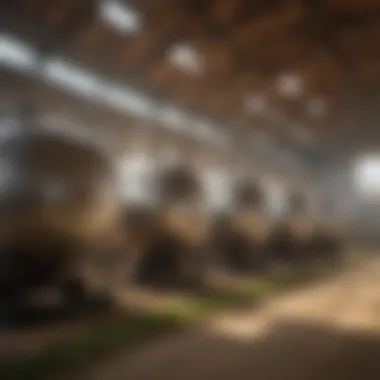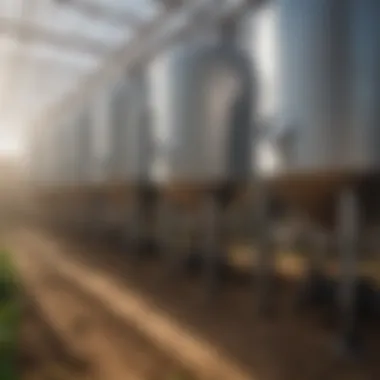Pre-Filled CO2 Tanks: Transforming Agriculture


Intro
Pre-filled CO2 tanks have emerged as essential tools in modern agriculture. They are particularly valuable in contexts where optimal growth conditions are crucial, such as greenhouses and controlled environments. Understanding the operation, benefits, and safety considerations of these tanks can significantly enhance agricultural practices.
This article will explore key concepts, recent innovations, and practical applications related to pre-filled CO2 tanks, providing farmers and gardening enthusiasts with a thorough grounding in this important area of agricultural technology.
Key Concepts and Terminology
Basic Definitions
Before delving into the intricacies of pre-filled CO2 tanks, it’s important to understand some fundamental terms.
- Carbon Dioxide (CO2): A colorless gas that plants utilize during photosynthesis to produce oxygen and glucose.
- Photosynthesis: The process by which green plants use sunlight, CO2, and water to create food.
- Controlled Environment Agriculture (CEA): Agricultural systems that rely on technology to control growing conditions for better quality and yields.
Historical Context
The use of CO2 in agriculture is not a new practice. The idea has evolved over decades, following initial studies that highlighted the benefits of CO2 enrichment in plant growth. Early adopters included large-scale commercial operations, gradually leading to wider acceptance among smaller farms and hobbyists. Today, pre-filled CO2 tanks have become a standardized tool in many greenhouse environments.
Recent Innovations and Trends
Technological Advancements
Recent innovations in CO2 tank technology have focused on improving efficiency and safety. Modern tanks are designed to withstand high pressures and are equipped with advanced regulators that allow for precise control of gas flow. Incorporating sensors that monitor CO2 levels ensures optimal conditions for plant growth.
Sustainable Practices
Sustainability is now a core principle in agriculture. The use of pre-filled CO2 tanks can reduce waste by supplying CO2 directly to plants without excessive emissions. Additionally, carbon capture technologies are being explored to source CO2 from atmospheric levels, further promoting sustainability.
Practical Applications and Techniques
Step-by-step Guides
Using pre-filled CO2 tanks involves several crucial steps:
- Determine CO2 Requirements: Assess the specific needs of the plants being grown. Different species may require different levels of CO2.
- Installation: Place the CO2 tank in a well-ventilated area, away from direct sunlight and extreme temperatures.
- Connection: Securely attach the regulator and hose to the tank following the manufacturer's guidelines.
- Monitoring: Regularly check CO2 levels within the growing environment using appropriate measurement tools.
- Maintenance: Ensure the tanks are regularly inspected and safely stored.
Case Studies
Numerous farmers who have adopted pre-filled CO2 tanks report substantial improvements in crop yields. For instance, a greenhouse in California documented a 30% increase in tomato production after implementing CO2 enrichment strategies. Another case involving lettuce cultivation showed enhanced growth rates and larger leaves, which benefited not only yield but also quality.
"Utilizing pre-filled CO2 tanks effectively can transform agricultural outcomes, offering both economic and ecological advantages."
In summary, pre-filled CO2 tanks are not just tools; they represent a pathway to more efficient and sustainable agricultural practices. Their role in enhancing plant growth cannot be overstated, as they help create optimal conditions for cultivation.
Prelude to Pre-Filled CO2 Tanks
In recent years, the significance of pre-filled CO2 tanks in agricultural practices has grown. These tanks are not just containers for gas; they represent a sophisticated solution for enhancing agricultural productivity. Farmers and agronomists increasingly recognize how controlled levels of carbon dioxide can lead to healthier plants and increased yields. Understanding the role of pre-filled CO2 tanks is essential for both new and experienced agricultural practitioners seeking to optimize their growing conditions.
Understanding CO2's Role in Plant Growth
Carbon dioxide is an essential component of photosynthesis, the process through which plants convert light energy into chemical energy. Plants absorb CO2 from the atmosphere, and its availability can significantly affect their growth rate. In well-managed environments, like greenhouses, increasing CO2 levels can stimulate plant growth, leading to notably higher yields. Research shows that elevated CO2 concentrations can enhance leaf area, accelerate flowering, and, ultimately, maximize produce output.
Experiments have consistently shown that crops grow better when CO2 levels are optimized. This knowledge drives the use of pre-filled CO2 tanks in agricultural settings. Farmers can elevate CO2 levels during critical growth periods, ensuring that plants receive the precise amounts they need for maximum growth.
What Are Pre-Filled CO2 Tanks?
Pre-filled CO2 tanks are pressurized containers filled with carbon dioxide. They are designed for easy use in agricultural settings. These tanks come in various sizes and capacities, making them suitable for different scales of operations, from small gardens to large commercial farms. The filling of these tanks is done at specialized facilities to ensure safety and adherence to quality standards.


Using these tanks allows for the rapid release of CO2 into growing environments. They can be connected to irrigation or aeration systems, enabling precise control over CO2 distribution. This precise application is key for optimizing plant growth, as it provides consistent access to the gas without relying solely on atmospheric levels. Farmers can manage their CO2 sources more effectively, ensuring that plants receive necessary nutrients without the risks associated with excess levels of growth.
"The use of pre-filled CO2 tanks marks a shift in how we approach agricultural growth enhancement. They bring efficiency and reliability to our farming practices."
The rise in popularity of pre-filled CO2 tanks also speaks to a broader trend towards sustainable agricultural methods. As concerns about environmental impacts grow, utilizing CO2 enrichment responsibly is a step towards balancing productivity with ecological considerations.
Applications in Agriculture
Agricultural practices have continually evolved with advancements in technology and methods. One of the crucial elements that has emerged is the use of pre-filled CO2 tanks. These tanks facilitate controlled environments that are optimal for plant growth. Their significance cannot be overstated; consistent and targeted CO2 application leads to increased efficiency and productivity in farming. By understanding the varied applications of pre-filled CO2 tanks, farmers can optimize their operations and achieve better outcomes.
Use in Greenhouse Environments
Greenhouses are designed to create ideal growing conditions for plants. The controlled environment found in a greenhouse allows for extended growth seasons and higher crop yields. The use of pre-filled CO2 tanks in this setting is vital. CO2 enrichment contributes to increased photosynthesis, which is essential for plant health. When CO2 levels are elevated, plants can convert sunlight into energy more eficiently. This not only promotes growth but also helps in disease resistance. Ideally, CO2 concentrations should be maintained between 1,000 and 1,500 ppm to get the best results.
The implementation of pre-filled CO2 tanks also simplifies the logistical aspects of greenhouse management. Instead of relying on natural CO2, which can be inconsistent, using tanks ensures a steady supply. This reliability is crucial for maintaining the desired environmental conditions. The setup is also user-friendly, adapting well to various greenhouse designs.
CO2 Enrichment for Hydroponics
In hydroponic systems, plants are grown without soil, relying on nutrient-rich water instead. Here, CO2 enrichment plays an essential role. CO2 levels directly influence growth rates and nutrient absorption. Hydroponics typically operates with a closed-loop system, making it more sensitive to fluctuations in CO2. Thus, utilizing pre-filled CO2 tanks can provide the necessary boost to achieve healthy plants and high yields.
These tanks allow farmers to fine-tune CO2 concentrations to match the needs of specific crops. The result is faster growth cycles and potentially larger harvests. Moreover, the precision of this method reduces waste and ensures that resources are used effectively. This approach aligns well with sustainable farming goals, minimizing the carbon footprint while maximizing output.
Enhancing Crop Yield Through CO2
The introduction of CO2 in the agricultural context ultimately revolves around the concept of enhancing yield. Studies show that crops exposed to higher CO2 concentrations frequently demonstrate improved growth metrics. Utilizing pre-filled CO2 tanks can help farmers achieve remarkable improvements in yield. An increase in CO2 can also facilitate quicker maturity rates in crops.
Another key element is the influence on flowering and fruiting processes. Higher levels of CO2 can lead to increased flower and fruit production, which is essential for commercial farming. The result of this process can lead to not only increased profit margins for farmers but also improved food supply overall. Implementing CO2 enrichment can thus be seen as a strategic investment in agricultural productivity.
"CO2 enrichment can transform agricultural practices, leading to significant yield improvements while adhering to sustainable farming principles."
Benefits of Pre-Filled CO2 Tanks
The use of pre-filled CO2 tanks in agriculture offers various advantages that enhance both productivity and efficiency in growing practices. Understanding these benefits is essential for farmers and gardening enthusiasts as they look to optimize their operations. Pre-filled CO2 tanks not only streamline the supply process but also provide a measurable input to the agricultural ecosystem, reinforcing the importance of controlled environments in promoting plant health.
Consistency and Reliability in Supply
One of the significant benefits of pre-filled CO2 tanks is their ability to provide a consistent and reliable supply of carbon dioxide. In agriculture, particularly in greenhouse settings, maintaining stable CO2 levels is crucial for plant photosynthesis. This process directly influences growth rates and crop yields.
Pre-filled tanks deliver CO2 without the variability associated with other sources. This ensures that plants receive an adequate supply regardless of external conditions. This consistency helps in minimizing gaps in plant growth cycles, thus providing farmers with a more predictable harvest. Furthermore, using pre-filled tanks reduces downtime since there’s no need for continuous monitoring and adjustments, allowing farmers to focus on other essential tasks.
Cost-Effectiveness Compared to Alternatives
When we compare pre-filled CO2 tanks to alternative methods of CO2 delivery, such as using CO2 generators or increasing natural ventilation, the cost-effectiveness of tanks becomes evident. The initial investment in pre-filled tanks may seem higher, but the savings in operational costs are substantial.
- Reduced Energy Costs: CO2 generators often rely on fuel sources for operation, leading to increased energy costs. Pre-filled tanks do not have such dependency, providing a stable cost model.
- Less Labor-Intensive: Managing CO2 levels using traditional methods often requires additional labor for setup and monitoring. Pre-filled tanks minimize the need for manual interventions, which can save time and labor resources.
These factors combined lead to a favorable economic situation for farmers focused on maximizing their productivity while minimizing unnecessary expenditures.
User Convenience and Maintenance
User convenience is another undeniable advantage of pre-filled CO2 tanks. They are designed for easy handling and usage.
- No Complex Setup Required: Unlike other CO2 systems which may require a complex configuration, pre-filled tanks come ready for immediate utilization. This allows users to implement CO2 enrichment without technical delays.
- Low Maintenance Needs: Once installed, pre-filled tanks demand little maintenance. Farmers do not have to worry about regular checks or complicated servicing routines, leading to less operational burden.
- Safety Features: Most modern pre-filled tanks integrate various safety features, such as pressure relief valves, to ensure safe usage. This added layer of safety contributes to a user-friendly experience.
"The convenience of pre-filled CO2 tanks allows farmers to concentrate on growth, not logistics."
The ease of use in conjunction with safety and low maintenance amplifies the appeal of pre-filled CO2 tanks for those in the agriculture sector.
In summary, the benefits of pre-filled CO2 tanks encompass consistency in supply, economic advantages, and user convenience. For agriculturalists seeking efficient and effective growth strategies, these tanks represent a valuable approach to meet both operational demands and financial goals.


Safety Considerations
Safety is paramount when working with pre-filled CO2 tanks in agricultural settings. Understanding and managing the risks associated with carbon dioxide is essential for protecting both personnel and crops. This section emphasizes the importance of safely storing, handling, and responding to emergencies related to CO2 tanks. By adhering to safety protocols, farmers can mitigate risks and create a secure environment for agricultural operations.
Proper Storage of CO2 Tanks
Storing CO2 tanks correctly is vital to maintaining safety. Tanks should be kept in a well-ventilated area to prevent the accumulation of gas. It is advisable to store them upright and on a stable surface to avoid tipping. Tanks must be secured to prevent them from falling over, and away from heat sources and flammable materials.
Regular inspections of storage areas should be conducted to ensure that there are no leaks or signs of damage. Proper signage should be displayed to inform personnel of the presence of CO2. Furthermore, it is crucial to maintain an access control policy to limit entry to authorized personnel only.
Handling Guidelines for Safety
When handling CO2 tanks, it is essential to follow strict guidelines to ensure everyone’s safety. Workers must wear appropriate personal protective equipment, such as gloves and safety glasses, to minimize the risk of frostbite and injury. When connecting or disconnecting tanks, it is important to always use tools designed specifically for this purpose.
Additionally, ensure that valves are closed when tanks are not in use. All personnel should be trained on the proper handling techniques and the potential hazards associated with CO2. Here are some specific guidelines for safe handling:
- Always inspect tanks for signs of damage or leaks before use.
- Use proper lifting techniques to handle filled tanks.
- Maintain a safe distance from the pressure relief valve when opening tanks.
Emergency Procedures and Training
In the event of a CO2 leak or another emergency, having clear procedures is key to ensuring safety. All personnel should be trained on how to respond to CO2-related incidents. The main response measures include:
- Evacuate the Area: When a leak is detected, the affected area should be evacuated immediately.
- Alert Emergency Services: Contact local authorities or emergency services for assistance.
- Ventilation: If safe to do so, ventilate the area to disperse accumulated CO2 gas.
- First Aid Training: Personnel should be trained in basic first aid, particularly in treating asphyxiation or respiratory issues resulting from CO2 exposure.
Proper training and readiness can significantly reduce risks associated with CO2 handling in agricultural practices.
Regular drills should be conducted to ensure all staff members are familiar with emergency procedures. This preparation helps create a culture of safety and increases awareness of potential hazards.
By focusing on these safety considerations, farmers can ensure a secure working environment while effectively utilizing pre-filled CO2 tanks.
Best Practices for Using Pre-Filled CO2 Tanks
The effective use of pre-filled CO2 tanks is critical for optimizing agricultural practices. This section outlines key practices that farmers and enthusiasts should follow to maximize the benefits of CO2 in plant growth. Incorporating these practices can lead to better crop yields, healthier plants, and efficient resource management.
Monitoring CO2 Levels in Growing Environments
Monitoring CO2 levels is paramount in maintaining the health of plants. Plants require the right concentration of CO2 for photosynthesis, and insufficient or excessive levels can impact growth adversely. The optimal range for CO2 enrichment typically falls between 1,200 to 1,800 ppm (parts per million).
Regular monitoring can be achieved using various methods:
- CO2 Sensors: These devices can provide real-time readings, ensuring that levels are within the desired range.
- Manual Checks: For smaller setups, manual measurement with a gas analyzer may work.
Farmers should consider integrating these monitoring solutions into their greenhouse or hydroponic systems. This ensures timely adjustments based on real-time data, allowing for precise CO2 application and enhancing overall plant performance.
Integrating with Other Growth Enhancements
To achieve optimal results, CO2 enrichment should not stand alone. Integrating CO2 supplementation with other growth factors such as light, temperature, and nutrients is vital.
- Lighting: Ensuring that plants receive adequate light complements CO2 usage. When CO2 levels rise, plants' need for light also increases to utilize the additional gas effectively.
- Watering and Nutrient Management: Balancing water and nutrient levels is crucial. CO2 can boost plant metabolism, leading them to consume more water and nutrients. Farmers should adjust their watering schedules and nutrient delivery accordingly.
This holistic approach often leads to synergies that improve growth, ultimately increasing yield and plant health.
Scheduling CO2 Application Efficiently
Efficient scheduling of CO2 application can significantly impact plant growth. Proper timing can help ensure that plants receive an adequate supply without wastage.
- Daytime Application: CO2 should generally be applied during the day when the plants are most active in photosynthesis. This enhances the utilization of CO2 by the plants.
- System Automation: Automated CO2 systems can help streamline the scheduling process. These systems can be programmed to release CO2 based on real-time monitoring data and preset conditions.
Adopting a strategic approach to scheduling can minimize costs and enhance plant growth, making it a critical factor in using pre-filled CO2 tanks effectively.


Incorporating best practices in CO2 applications can lead to significant improvements in crop yield and plant vitality. Continuous assessment of these practices will lead to evolving and sustainable agricultural methods.
Challenges and Limitations
Understanding the challenges and limitations associated with pre-filled CO2 tanks is crucial for their effective integration into agricultural practices. While these tanks offer significant benefits in enhancing plant growth and optimizing resources, certain concerns must be addressed. This section discusses potential risks involved in their usage as well as environmental aspects that growers need to consider.
Potential Risks of Over-Enrichment
One of the primary concerns when using pre-filled CO2 tanks is the risk of over-enrichment of carbon dioxide in growing environments. Increased CO2 levels can stimulate plant growth, but excessive concentrations can lead to negative effects.
- Impact on Plant Health: Over-enrichment can disrupt physiological processes in plants. For instance, while high levels can enhance photosynthesis, too much CO2 can lead to stomatal closure. This prevents plants from taking in needed water, resulting in stress or even damage.
- Crop Quality: There are implications for crop quality. Over-enrichment could change the nutritional profile and taste of produce, which may affect marketability and consumer preferences.
- Monitoring Needs: Farmers must therefore invest in reliable monitoring equipment. Regular checks of CO2 levels become essential to avoid unintended consequences. Not doing so could lead to reduced yields and financial losses.
"Monitoring CO2 concentration is as important as the enrichment itself; balance is key.”
Environmental Considerations in Usage
The use of pre-filled CO2 tanks also brings environmental considerations to the forefront. Sustainable agricultural practices are not just about maximizing output, but also about understanding the environmental effects of these practices.
- Carbon Footprint: Even though CO2 is a natural constituent of the atmosphere, the production and transportation of pre-filled tanks may contribute to a higher carbon footprint. It is important for farmers to consider sourcing locally and evaluating suppliers who maintain sustainable practices.
- Regulatory Compliance: Compliance with local and regional environmental regulations is necessary. Farmers must ensure that their CO2 usage adheres to laws aimed at minimizing emissions and protecting local ecosystems.
- Biodiversity Impact: Adjusting CO2 levels can inadvertently affect local biodiversity. Elevated CO2 can benefit certain species over others, potentially disrupting ecological balances.
In summary, while pre-filled CO2 tanks offer significant advantages in agricultural practice, awareness of the challenges and limitations is essential. Farmers should adopt best practices to mitigate risks, ensure environmental compliance, and monitor operational impacts effectively.
Future Trends in CO2 Management
The evolving landscape of agriculture calls for adaptive strategies. Future trends in CO2 management are essential for ensuring sustainability and efficiency in farming. The integration of innovative practices can help optimize the use of CO2, while also minimizing negative environmental impacts. Understanding these trends is vital for farmers who seek to improve productivity while being mindful of their ecological footprint.
Innovations in CO2 Delivery Systems
The advancement in CO2 delivery systems is driving significant improvements in agricultural practices. Traditional methods are being replaced by more sophisticated technologies. For instance, the development of automated CO2 injection systems allows for precise application based on real-time data. Sensors monitor plant growth and environmental conditions, adjusting CO2 levels accordingly.
Additionally, smart controllers can interface with greenhouse environments. They enable farmers to manage CO2 levels more effectively. These systems often link up with other environmental controls, such as humidity and temperature, to provide a cohesive growth strategy. Innovations like these reduce waste and enhance crop growth efficiency, maximizing resource use.
"Innovative delivery systems not only increase efficiency but also promote sustainability in agricultural operations."
Sustainability and Carbon Footprint Reduction
Sustainability is increasingly at the forefront of agricultural practices. Reducing carbon footprint has become a central concern for modern farmers. Implementing sustainable CO2 management is an effective way to address this issue. Growing awareness among consumers about sustainable practices places pressure on farmers to adopt eco-friendly methods.
Efforts to lower CO2 emissions involve exploring alternative practices. For example, some farms are investing in renewable energy sources to power CO2 generation. This approach alleviates dependence on fossil fuels, contributing to significant reductions in overall greenhouse gas emissions.
Moreover, many growers are focusing on carbon offset initiatives. These may include activities such as reforestation or soil health improvement strategies that enhance carbon sequestration. By integrating these practices, farmers can balance their CO2 usage with effective measures to combat climate change.
In summary, the future of CO2 management in agriculture leans towards innovation and sustainability. By adopting new technologies and practices, farmers can meet productivity goals while ensuring ecological integrity.
Closure
In the realm of agriculture, the strategic implementation of pre-filled CO2 tanks underscores their essential role in promoting plant vitality and increasing yield. This article elucidates the multifaceted significance of CO2 in agricultural practices. By recapitulating the importance of carbon dioxide, we can recognize it as more than just a basic need for photosynthesis; it is a crucial component in the intricate web of agricultural efficiency and sustainability.
Recapitulating the Importance of CO2 in Agriculture
CO2 is a fundamental element for plant growth. Its role is paramount in photosynthesis, the process by which plants convert light into energy. During this process, plants absorb carbon dioxide from the atmosphere, converting it into oxygen and glucose. This transformation is vital not just for plant health, but also for the broader ecosystem, sustaining life forms ranging from insects to humans.
Furthermore, enhancing CO2 levels in controlled environments like greenhouses can lead to significant improvements in plant growth rates. With higher levels of CO2, plants can photosynthesize more efficiently, often resulting in increased biomass and better quality produce. This is invaluable for farmers aiming to meet the growing food demands of an ever-expanding population. In summary, recognizing the essential functions of CO2 in agriculture positions it as a necessary factor in promoting sustainable farming practices.
Encouraging Safe and Effective Use of CO2
While the advantages of utilizing pre-filled CO2 tanks are substantial, it is equally important to prioritize safety and effective management. First and foremost, proper handling and usage guidelines must be established and followed. A knowledgeable workforce is crucial to ensure that CO2 delivery systems operate safely while avoiding over-enrichment scenarios that can lead to adverse effects on crops and the surrounding environment.
Farmers and agricultural professionals should invest in comprehensive training programs focusing on:
- Understanding CO2 levels: Establish clear measurement protocols to monitor concentrations.
- Handling procedures: Train staff on how to safely connect and disconnect tanks, minimizing the risk of leaks.
- Emergency response: Implement clear procedures for any accidental release, including evacuation plans and immediate alerting protocols.
Implementing these practices not only safeguards personnel but also enhances overall efficiency when integrated into agricultural strategies.
By embracing these safety measures while leveraging the benefits of pre-filled CO2 tanks, the agricultural sector can not only boost productivity and crop quality but also do so in a sustainable and responsible manner, ultimately fostering a healthier environment.















